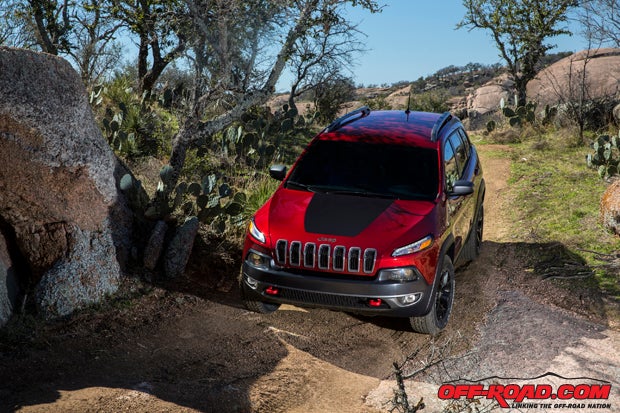
With one foot in the past and an eye toward the future, Jeep will enter 2014 with an all-new mid-size SUV using the legendary Cherokee name. After a year absence in the segment, the Cherokee replaces the discontinued Liberty with a vehicle that Jeep says improves fuel economy by 45 percent, provides best in-class capability in off-road performance and towing, and features “superior” on-road ride and handling.
But is the new Cherokee truly a “Jeep”?
Our answer might sound like a copout, but here it is: The Cherokee is and isn’t truly a Jeep, all at the same time. It’s true that the Cherokee clearly represents a step toward the future for the Jeep brand and also returns it to a large market sector, but that sector is not necessarily known for attracting the hard-core off-road enthusiasts that effectively built the brand.
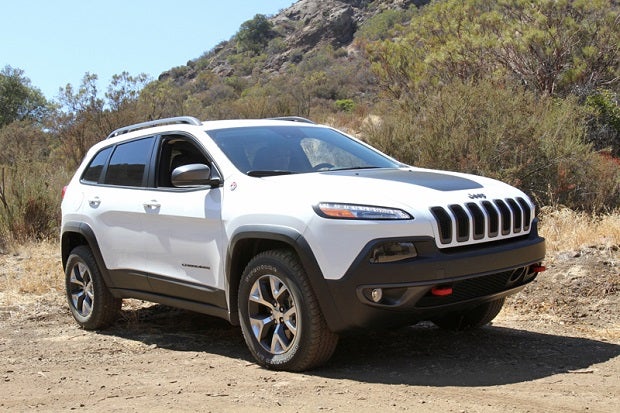
As Head of Jeep Design Mark Allen explained to us, Jeep’s lineup is essentially split up between the boxy design of the Jeep Wrangler and the curvier, more muscular shape of the Grand Cherokee. Interestingly enough, the previous Cherokee would have fit into the latter “boxy” category, but the redesign of the 2014 Cherokee has it more closely resembling the sleeker, round-edged Grand Cherokee.
Get the Flash Player to see this player. |
But although the Cherokee definitely sports a more refined “crossover” appearance, it still wears Jeep badging, meaning that there are definitive and historic performance standards that must be met, and that’s something that Jeep engineers and designers take very seriously. So off-road capability is an important aspect to the Cherokees, or at least one of them. There are four trim levels for the Cherokee – the Sport, Latitude, Limited and Trailhawk, with the Trailhawk being the package off-roaders will desire since it is “Trail Rated.” That designation is more than just a marketing slogan, as it means that the Trailhawk is designed to perform to Jeep’s standards in five key off-road categories, including traction, ground clearance, maneuverability, articulation and water fording.
The 2014 Jeep Cherokee will be offered with two different engine packages. The 2.4-liter Tigershark MultiAir inline four-cylinder motor boasts up to 31 mpg on the highway, which is a 45 percent improvement over the Liberty, and provides nearly 500 miles of range on a tank of gasoline. The Tigershark MultiAir is rated to produce 184 horsepower and 171 lb.-ft. of torque, and it boasts a crawl gear ratio of 56:1.
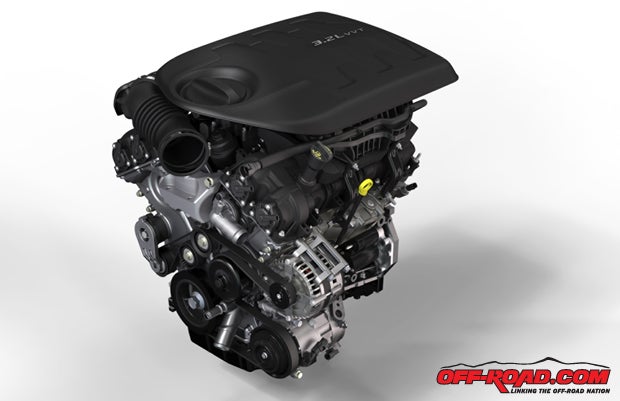
The Cherokee will also be offered with a new 3.2-liter Pentastar V6 that is based on the popular 3.6-liter engine currently available in the Wrangler and Grand Cherokee. The Pentastar V6 is rated at 271 horsepower and 239 lb.-ft. of torque, boasts best-in-class towing at 4500 pounds and features a 48:1 crawl ratio. Jeep says the Pentastar V6 delivers a 30 percent improvement in fuel economy compared the outgoing Liberty V6 motor. For what it’s worth, the engine is also E85 compatible.
Both engines will be mated to the segment’s first nine-speed transmission, the 948TE, which helps provide improved low-end power for the road and the dirt, smooth delivery at highway speed and better fuel economy across the board.
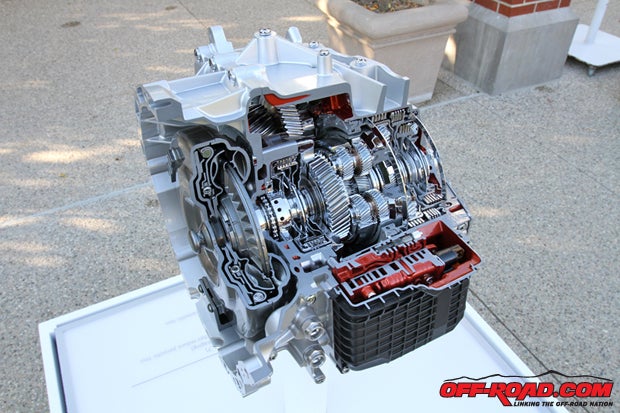
The new Cherokee chassis uses a shared design via Chrysler’s partnership with the FIAT Group. Designated as the CUS-wide (Compact U.S. Wide), it is designed for potential use across multiple platforms, and it features common, modular and interchangeable component that allows for modularity of the wheelbase, front track, rear track, front overhang, length and width across different vehicle lines. The chassis itself has a high-strength steel content of roughly 65 percent.
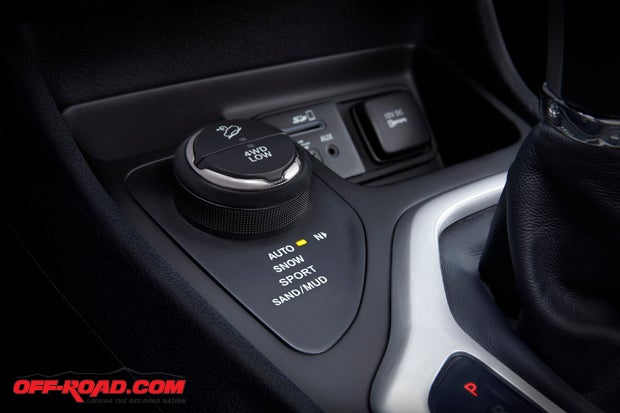
The Selec-Terrain traction control system is available on all four-wheel-drive models of the Cherokee. The Auto mode runs in standard drive mode and will help detect the need for four-wheel-drive engagement and provide a fully active and variable front/rear torque split. Sport mode is designed for enhanced on-road control for the driver, as it limits traction control, raises ESC slip thresholds, and allows for a front/rear torque split of up to 40/60 percent. Snow mode provides a second-gear launch to reduce slippage, slick-surface electronic brake controls, full-time four-wheel drive and allows for a front/rear torque split of up to 60/40 percent. Mud/Sand mode is designed for improved performance off-road. It activates full-time four-wheel drive, off-road electronic brake controls and allows a front/rear torque split of up to 100 percent rear. There is also a Rock mode, which is only available on the Trailhawk version and is designed for use on off-road obstacles. Rock mode only works in 4-Low, allowing for a front/rear torque split of up to 100 percent rear and off-road electronic brake controls with “increased brake lock differential capacity.”
Three different 4x4 systems are available on the Cherokee. Active Drive 1, available on the Sport, Latitude and Limited models, features a single power transfer unit that is fully automatic. Active Drive II is also available on the Sport, Latitude and Limited models and features a two-speed power transfer unit with torque management and low range. The 4-Low setting locks the front and rear driveshafts for low-speed power or towing. The low range will provide a 2.92:1 gear reduction to aid in climbing or for tackling tough off-road obstacles. Active Drive II also works in conjunction with the Select-Terrain system to modify torque distribution and help deliver ideal traction. When in neutral, vehicles with Active Drive II can disconnect the driveline for flat towing behind another vehicle.
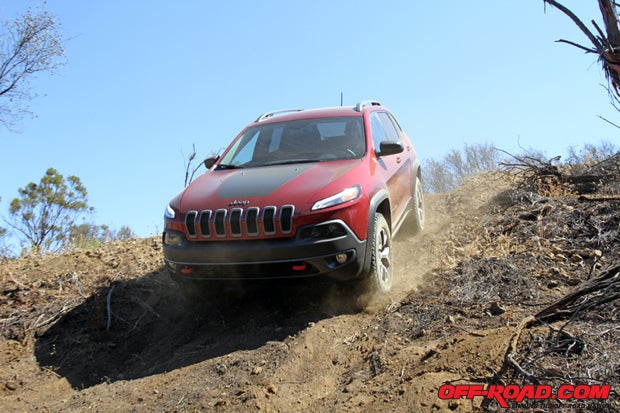
Active Drive Lock can be found on the Trailhawk. It offers all of the features of Active Drive II with the addition of a locking rear differential for off-roading. The rear locker can be selected in any low-range terrain mode (though it will automatically lock in “Rock” mode).
Jeep’s Select-Speed Control system will aid the driver in off-road conditions. Hill-Ascent Control and Hill-Descent Control will provide assisted operation of the vehicle’s speed in both uphill and downhill off-road conditions, allowing the driver to focus on steering input without worry of operating the gas pedal. The ESC system controls engine torque and brake pressure when traveling over obstacles to help maintain speed when while driving uphill, on level ground or traveling downhill. The system is operated via a dedicated switch (only in 4-Low), with the driver then being able to adjust speed with the +/- on the shifter from roughly 1 to 5 mph.
The Trailhawk features a running ground clearance of 8.7 inches, providing two additional inches of lift over the other Cherokee models (1 inch via suspension, another inch via the larger-diameter tires). The Trailhawk also has significantly improved off-road performance thanks to a 29.8-degree approach angle, a departure angle of 32.1 inches and a breakover angle of 23.3 inches.
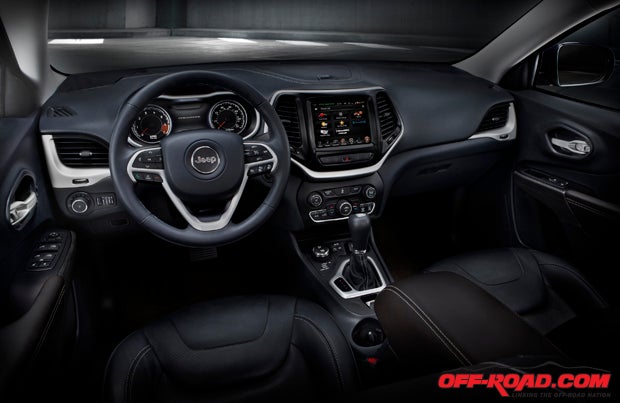
Inside the new Cherokee, Jeep designers explained the interior features a “Bird of Prey” design layout. The center stack was explained to be inspired by a Willys grill (maybe a bit of a stretch, but a connection to the past for designers). An 8.4-inch touchscreen multimedia command center or a 5-inch touchscreen is available for the center stack, with available Uconnect allowing the driver to control the audio, climate controls, seat ventilation, phone app pairing (and phone functions such as multiple text message options), and more. The instrument cluster is a thin-film transistor (TFT) LED 5-inch grayscale or 7-inch full-color reconfigurable cluster, featuring options for display such as turn-by-turn navigation, speed, real-time fuel economy, safety warnings, Adaptive Cruise Control, audio information, or even Selec-Terrain information.
There’s quite a bit of storage space in the Cherokee. Above the center stack is a covered top bin for smaller items. The front passenger seat actually folds flat to reveal an under-seat-cushion storage section. The glove box is designed to hold an iPad or most laptop computers. The center console itself features an integrated phone-docking station, USB and SD ports as well as an auxiliary power source. There’s storage underneath the center armrest as well.
As for seating, Jeep designed the second-row seats on the Cherokee to move 6 inches fore or aft to accommodate the need for more storage or passenger legroom. The Jeep Cargo Management System in the rear storage area features a module rack mounted to the side of the section to provide for hooks for securing gear. (An optional off-road accessory kit is available for the Trailhawk that include a towrope, gloves, and more).
The new Cherokee also delivers a few unique features, such as a first-for-Chrysler-Group-vehicle ParkSense Parallel/Perpendicular Park Assist System (say that three times fast), which is operated via buttons on the steering wheel and the shifter. Speaking of buttons, we did note there are 16 buttons on the front of the steering wheel (18 in total if you count the rocker stereo controls on the backside). Jeep makes the CommandView dual-pane sunroof available for the first time in a mid-size SUV on the Cherokee, while the “industry-exclusive” SkySlider open-air sunroof will be an available option as well.


 Your Privacy Choices
Your Privacy Choices